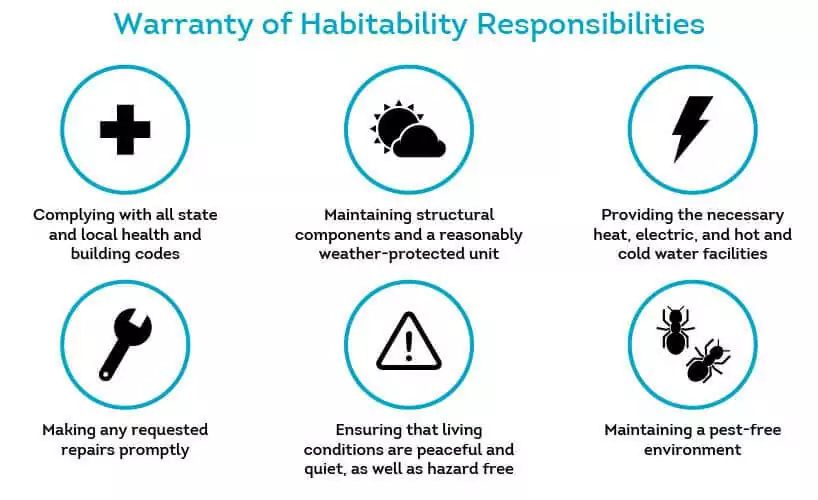Picture this: you’ve finally found the ideal tenant for your rental property — responsible, reliable, and respectful. But six months in, they drop a bombshell — they need to break the lease early. What leads even the best tenants to such decisions, and how can landlords handle unexpected situations with grace?
If you’re looking for ways to solve issues that arise with tenants (or trying to prevent issues before they happen), we have solutions that can help you save time, run operations more smoothly, and prevent excessive turnover.
Keep in mind we’re not legal professionals, so you shouldn’t treat this as legal advice. We encourage you to speak with a lawyer for advice about your specific business operations..
Now, let’s take a look at some common renter problems and how you can potentially approach them more effectively:
1. Unpaid or late rent
We’re kicking off with one of the biggest landlord/tenant issues — people who forget (or pretend to forget) to pay rent on time. This inevitably comes up for any landlord or property manager, regardless of how many doors they manage.
But before you gear up for small claims court, take some advice from David Ciccarelli, CEO of the online vacation rental platform Lake:
- If the rent is late, but the tenant reliably pays on time: A gentle reminder is often enough to get them moving. You may want to turn to rent reminder texts to prevent delays in the future.
- If the renters are in a difficult financial situation but are otherwise great tenants: You can offer a payment plan to help them catch up over the next few months. Remember: you’re providing physical safety for people, so don’t move to start the eviction process unless the situation warrants it.
In day-to-day property management, if you’re forced to go to court to enforce the lease, you’ve already lost.
— Moses Kagan (@moseskagan) April 29, 2024
To reduce late rent payments, you may want to implement late fees into your lease. This is typically 5% of the rent, but check your state laws to make sure you’re following guidelines.
If you feel eviction is inevitable for a tenant, you should talk to your lawyer about landlord-tenant laws. Again, familiarize yourself with relevant legislation so you know what to do during the eviction process.
2. Early lease termination
Tenants wanting to end their lease early is a common problem for landlords who don’t have a buy-out or release clause in their lease. In slower markets where it takes longer to find a renter, an unexpected move-out could put you in a bind.
Again, this is a situation you should deal with on a case-by-case basis. Most people think tenants should always get penalized if they break a lease, but there are situations where you may be able to find a mutually beneficial solution.
Here’s some advice from the team at TurboTenant:
- Tenant needs to move for a new job: This is the most common reason tenants break their lease. If the tenant gives at least a 60-day notice, you’ll have enough time to find a new tenant and potentially even increase the rent.
@turbotenant A few common reason why tenants can (and should) break their lease early. 📝🔑 #turbotenant #propertymanagement #leasebreak #leasebreaker #landlordlife #landlordproblems #landlordsoftiktok #propertymanagementsoftware ♬ original sound – TurboTenant
- Tenant is an active duty service member: If your tenant gets orders to relocate for over 90 days, they’re allowed to break the lease. This can’t be penalized, but landlords can ask for proof. Tenants must provide 30 to 60 days written notice with an effective end date.
- Tenant feels unsafe: This is a red flag you’re dealing with a bigger issue. You should immediately ask your tenant more questions, gather information from them, and try to make them feel safer if possible. Don’t forget to remind them you care about their well-being.
Keep in mind you’re usually allowed to add an early termination fee to your lease. This is typically two months of rent, but you can opt for a different structure, depending on the laws in your state.
Either way, make sure to outline this in your rental agreement to set clear expectations before tenants sign the dotted line.
3. Maintenance issues
From plumbing leaks and electrical issues to heating and cooling malfunctions, plenty of things can go wrong in a rental. Most (but not all) of them will disrupt your tenant’s quality of life, so they’ll need your attention to resolve the issue quickly.

Under federal law, it’s the tenant’s right to have a safe and habitable home. Some tenants may make unreasonable repair requests, but most people just want to feel comfortable and safe.
With this in mind, here’s how to address common maintenance requests:
- Tenant has pest issues: Ask tenants to report maintenance issues promptly in writing – either through your property management app tenant portal or via text.
- Tenant has an appliance breakdown: Use the same process as above — ask the tenant to report problems in writing. From there, next steps depend on who has the responsibility to pay according to your lease terms.
Don’t forget to follow the warranty of habitability in your state, which lists the bare minimum requirements for livable rentals.
4. Security deposit disputes
There may be disagreements over non-returned or partially returned security deposits because of damages, cleaning expenses, or other reasons. A paper trail will be your best friend here, and a well-written lease can help set expectations early.
Here are some suggestions for dealing with security deposit disputes:
- Tenant leaves property semi-clean: Ask the tenant to review your lease agreement to understand the expectations regarding the condition of the property upon vacating. Don’t forget to take and store plenty of pictures as evidence during disputes.
- Tenant leaves furniture: Refer to local laws to see how to proceed. In New York City, for example, renters must remove all personal belongings before vacating the unit. If they don’t, you can’t keep their belongings — you’ll have to hire someone to remove them for you.
- Tenant damages appliances or furniture: Ask the tenant to refer to your move-in inspection to avoid escalation. You can do a final inspection with the tenant to ensure everyone’s on the same page.
5. Noise problems
Noise problems can refer to a range of issues, from noisy neighbors to construction projects and even renters with different schedules.
Forreal!
byu/lilsma999 inmemes
You can’t smooth over every situation, but you can stop smaller problems from turning into bigger issues.
Here are some suggestions for resolving noise problems peaceably:
- Tenant has a noise complaint about a neighbor: Start by investigating the situation and speaking to each neighbor separately. Once you understand what’s going on, try moving one (or both) parties to a different unit if the noise doesn’t fall under local noise ordinances or other relevant legal boundaries.
- Nearby construction: Set expectations for tenants (if you can) about when the construction will end. You may also want to research when construction projects are allowed to legally operate — anything past 5 PM may constitute a disturbance, depending on your local ordinances. After acknowledging the disruption, you may want to offer some kind of compensation to the affected tenants, such as car wash coupons, a rent reduction, or something else along those lines.
- Forbidden activity: Any noise that goes against the terms of your lease qualifies as forbidden activity. This could be a large house party, loud music, or excessive noise during quiet hours. If you don’t already have a noise clause in your lease, you should write an addendum so you have grounds to enforce the consequences.
Proactive measures to avoid tenant problems
Preventing every tenant problem simply isn’t possible.
But if you’re looking for proactive advice, read on for our suggestions.
1. Take an inventory of property (especially if furnished)
You can’t manage what you don’t measure, especially property damage. That’s why it’s essential to take inventory before the tenant’s move-in date so you can get a better idea of the unit’s before and after condition.
“You should always do a move-in inspection alongside tenants so they can sign off on any preexisting conditions of the appliances, floors, walls, and fixtures, taking photos and videos to back up your notes. Doing this with the tenant helps protect your investment, and it shows tenants you respect them enough to provide full transparency.” – David Ciccarelli
Again, doing this inspection together helps build trust and good landlord-tenant communication.. Do it alone, and your tenant might worry that minor damage wasn’t caught in the inspection.
2. Do proactive regular maintenance
As mentioned earlier, it’s the landlord’s responsibility to ensure the property is in good condition, free of pests, and habitable. Performing regular check-ins and proactive maintenance can help you check for property damage and quickly address concerns.
“Investing in proactive maintenance is essential. So many tenants have been wronged by poor landlords, so showing them you care to keep their unit in good shape is crucial,” David says.
David provides a few concrete suggestions:
- Evaluate the property 3-4 times annually
- Perform maintenance quickly
- Keep your tenants happy
“As a bonus, great maintenance usually allows you to charge more rent and save on repair costs later,” he adds.
3. Invest in background checks and vetting
Most (but not all) serious tenant problems are avoidable with the right tenant screening process. “After years of renting properties, one of the biggest things I’ve learned is the importance of vetting tenants properly from the start,” says Ryan Nelson, founder and CEO of Rental Real Estate.
Ryan recommends keeping an eye out for things like defaulting on rent payments, a criminal history, credit scores, and other factors.
“Thoroughly checking references upfront can uncover warning signs you wouldn’t see otherwise. Even if it takes a bit more time at first, it prevents much bigger headaches later on. Meeting potential renters in person gives valuable insights, too. Seeing how they interact gives a sense of what kind of residents they’ll be.” – Ryan Nelson
4. Create a lease agreement that covers all bases
An airtight lease agreement will help you sleep better at night and keep tenants accountable if the need arises.
If you’re a newer landlord, you can use a template resource from the American Apartment Owners Association. Then, you can add clauses and addendums as your business grows.
Samantha Odo, Real Estate Sales Representative & Montreal Division Manager at Precondo, suggests, “Lay out the expectations and responsibilities of both parties from the get-go. One time, I had a tenant who constantly violated noise regulations outlined in the lease agreement. Instead of resorting to confrontations every time there was a noise complaint, I simply referred back to the lease agreement, which clearly stated the rules regarding noise disturbances.”
Putting it into practice
Your goal as a landlord shouldn’t be to avoid all issues — because tenant problems are inevitable, even with a great lease agreement. So instead, you should focus on being proactive and stopping issues before they begin.
Of course, tenant problems are just one piece of the landlord puzzle. Because, as you know, there are tenant problems, and there are tenants who are the problem.
How do you navigate these tricky situations?
Read our guide on how to deal with difficult tenants.
